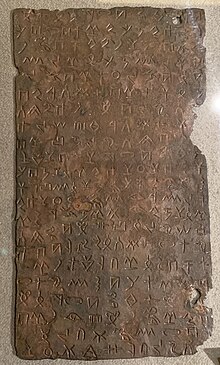Aksara Biblos
Aksara Biblos, juga dikenal sebagai aksara silabis Biblos, aksara pseudo-hieroglif, atau proto-biblos adalah sistem penulisan yang tidak terbaca, dikenal melalui sepuluh prasasti yang ditemukan di Biblos. Aksara ini terukir di piring perunggu, spatula dan batu. Digali oleh Maurice Dunand dari 1928 hingga 1932, dan diterbitkan pada 1945 dalam monografinya Byblia Grammata. Prasasti tersebut berasal dari milenium kedua SM, diduga antara abad ke-XVIII dan ke-XV SM.
| Aksara Biblos | |
|---|---|
 | |
| Jenis aksara | Tidak terbaca (mungkin aksara silabis atau Abugida)
|
| Bahasa | Tidak diketahui |
Periode | Diperkirakan antara 1800 SM dan 1400 SM |
| Aksara terkait | |
Silsilah | |
Contoh aksara ini juga ditemukan di Mesir, Italia, dan Megiddo (Garbini, Colless).
Jan Best, sejarawan prasejarah dan protosejarah dari Belanda, percaya bahwa dia berhasil menguraikan suku kata Biblos setelah 40 tahun penelitian.[1] Ulasan bukunya pada 2010 Het Byblosschrift ontcijferd (Uraian Aksara Biblos) agak kacau. Yang terbaik adalah bahwa aksara Linear A dari Kreta memiliki sejumlah karakteristik Semit. Namun para sarjana bahasa Yunani kuno menentang pernyataan ini, mereka cenderung percaya bahwa Kreta berhubungan dengan asal-usul budaya Helenistik.[2]
Kesusasteraan
sunting- Best, Jan Het Byblosschrift ontcijferd - In het voetspoor van Willem Glasbergen 2010 (ISBN 9789035136007)
- Best, Jan Suruya in the Byblos Script: Corpus, Ugarit-Forschungen 40 (2009), 135-41
- Best, Jan Breaking the Code of the Byblos Script, Ugarit-Forschungen 40 (2009), 129-33
- Colless, Brian, "The Byblos Syllabary and the Proto-alphabet", Abr-Nahrain/Ancient Near Eastern Studies 30 (1992), 15-62
- Colless, Brian, "The Canaanite Syllabary", Ancient Near Eastern Studies 35 (1998), 26-46.
- Colless, Brian E., "The Origin of the Alphabet: An Examination of the Goldwasser Hypothesis", Antiguo Oriente 12 (2014) 71-104.
- Daniels, P.T., "Pseudo-hieroglyphs of Byblos", in: P.T. Daniels & W. Bright (eds.), The World's Writing Systems (New York/Oxford, 1996), 29-30.
- Dhorme, Édouard, 'Déchiffrement des inscriptions pseudohiéroglyphiques de Byblos', in: Syria 25 (1946–1948).
- Dunand, Maurice, 'Spatule de bronze avec épigraphe phénicienne du XIIIe [actually: Xe] siècle', in: Bulletin du Musée de Beyrouth 2 (1938) 99–107. (Spatula with traces of Proto-Byblian writing)
- Dunand, Maurice (1945). Byblia Grammata: Documents et recherches sur le développement de l’écriture en Phénicie. Beirut: République Libanaise, Ministère de l’Éducation National des Beaux-Arts.
- Garbini, Giovanni, [review of Mendenhall's book], in: Rivista di Studi Fenici 16 (1988), 129-131.
- Hoch, James E. (1990). "The Byblos Syllabary: Bridging the Gap Between Egyptian Hieroglyphs and Semitic Alphabets". Journal of the Society for the Study of Egyptian Antiquities. 20: 115–124.
- Martin, Malachi, The Scribal Character of the Dead Sea Scrolls, Vol. 1, Bibliothèque du Muséon 44, Publications Universitaires, Louvain, 1958
- Martin, Malachi, The Scribal Character of the Dead Sea Scrolls, Vol. 2, Bibliothèque du Muséon 45, Publications Universitaires, Louvain, 1958
- Martin, Malachi, 'Revision and reclassification of the Proto-Byblian signs', in: Orientalia 31 (1962) 250-271, 339-363.
- Mendenhall, George E., The Syllabic Inscriptions from Byblos, Beirut, The American University (1985), Syracuse University Press (1986), ISBN 0-8156-6077-4.
- Sobelman, Harvey, 'The Proto-Byblian inscriptions: a fresh approach', in: Journal of Semitic Studies 6 (1961) 226-245.
- Thiollet, Jean-Pierre, Je m'appelle Byblos, H & D (2005), ISBN 2-914266-04-9.